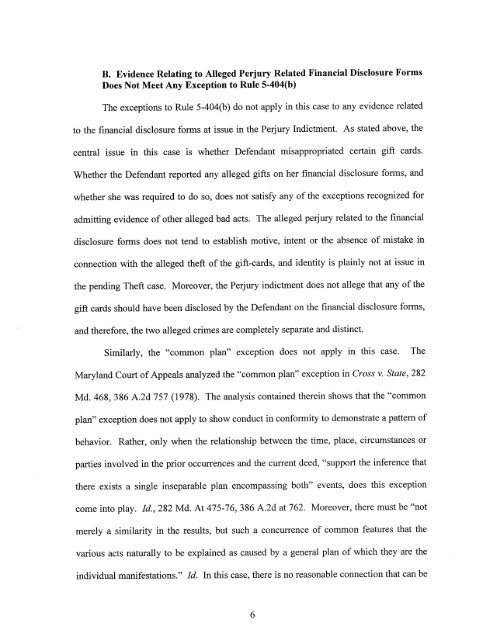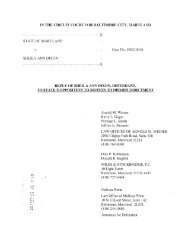Motion in Limine to Exclude Evidence of Other Acts - Dixon
Motion in Limine to Exclude Evidence of Other Acts - Dixon
Motion in Limine to Exclude Evidence of Other Acts - Dixon
You also want an ePaper? Increase the reach of your titles
YUMPU automatically turns print PDFs into web optimized ePapers that Google loves.
B. <strong>Evidence</strong> Relat<strong>in</strong>g <strong>to</strong> Alleged Perjury Related F<strong>in</strong>ancial Disclosure Forms<br />
Does Not Meet Any Exception <strong>to</strong> Rule 5-404(b)<br />
The exceptions <strong>to</strong> Rule 5-404(b) do not apply <strong>in</strong> this case <strong>to</strong> any evidence related<br />
<strong>to</strong> the f<strong>in</strong>ancial disclosure forms at issue <strong>in</strong> the Perjury Indictment. As stated above, the<br />
central issue <strong>in</strong> this case is whether Defendant misappropriated certa<strong>in</strong> gift cards.<br />
Whether the Defendant reported any alleged gifts on her f<strong>in</strong>ancial disclosure forms, and<br />
whether she was required <strong>to</strong> do so, does not satisfy any <strong>of</strong> the exceptions recognized for<br />
admitt<strong>in</strong>g evidence <strong>of</strong> other alleged bad acts. The alleged perjury related <strong>to</strong> the f<strong>in</strong>ancial<br />
disclosure forms does not tend <strong>to</strong> establish motive, <strong>in</strong>tent or the absence <strong>of</strong> mistake <strong>in</strong><br />
connection with the alleged theft <strong>of</strong> the gift-cards, and identity is pla<strong>in</strong>ly not at issue <strong>in</strong><br />
the pend<strong>in</strong>g Theft case. Moreover, the Perjury <strong>in</strong>dictment does not allege that any <strong>of</strong> the<br />
gift cards should have been disclosed by the Defendant on the f<strong>in</strong>ancial disclosure forms,<br />
and therefore, the two alleged crimes are completely separate and dist<strong>in</strong>ct.<br />
Similarly, the "common plan" exception does not apply <strong>in</strong> this case. The<br />
Maryland Cour <strong>of</strong> Appeals analyzed the "common plan" exception <strong>in</strong> Cross v. State, 282<br />
Md. 468, 386 A.2d 757 (1978). The analysis conta<strong>in</strong>ed there<strong>in</strong> shows that the "common<br />
plan" exception does not apply <strong>to</strong> show conduct <strong>in</strong> conformity <strong>to</strong> demonstrate a pattern <strong>of</strong><br />
behavior. Rather, only when the relationship between the time, place, circumstances or<br />
parties <strong>in</strong>volved <strong>in</strong> the prior occurrences and the current deed, "support the <strong>in</strong>ference that<br />
there exists a s<strong>in</strong>gle <strong>in</strong>separable plan encompass<strong>in</strong>g both" events, does this exception<br />
come <strong>in</strong><strong>to</strong> play. ¡d., 282 Md. At 475-76,386 A.2d at 762. Moreover, there must be "not<br />
merely a similarty <strong>in</strong> the results, but such a concurrence <strong>of</strong> common features that the<br />
various acts naturally <strong>to</strong> be expla<strong>in</strong>ed as caused by a general plan <strong>of</strong> which they are the<br />
<strong>in</strong>dividual manifestations." ¡d. In this case, there is no reasonable connection that can be<br />
6

















